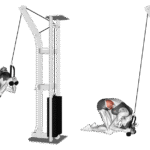One-Arm Dumbbell Preacher Curl: Exercise Overview
The one-arm dumbbell preacher curl is an effective isolation exercise designed to target the biceps brachii, with secondary engagement of the brachialis and forearms. By isolating one arm at a time on a preacher bench, this movement minimizes momentum and promotes balanced bicep development, making it ideal for correcting strength imbalances and enhancing arm aesthetics.
This exercise is a staple for arm-focused workouts, upper-body sessions, or full-body routines, offering a controlled environment to maximize bicep contraction. It’s suitable for lifters of all levels aiming to sculpt defined arms and improve unilateral strength (Schoenfeld, 2010).
How to Perform the One-Arm Dumbbell Preacher Curl
- Adjust the preacher bench seat so your upper arms rest comfortably flat on the padding when seated.
- Sit on the bench, grasp a dumbbell with your left hand using a supinated grip (palm facing up), and rest the back of your left upper arm fully on the pad, arm extended—this is your starting position.
- Place your right forearm on the pad for additional support and stability.
- Slowly curl the dumbbell upward toward your shoulder, focusing on contracting the bicep at the top of the movement.
- Pause briefly at the top, squeezing the bicep, then lower the dumbbell back to the starting position with control, fully extending your arm.
- Repeat for the desired number of repetitions, then switch to the right arm.
Tips for Optimal Performance
- Start with the Weaker Arm: Begin with your weaker arm (often the left) to ensure balanced effort and development across both biceps (Schoenfeld, 2016).
- Control the Movement: Perform the curl and descent slowly to maximize time under tension and enhance bicep activation, avoiding momentum (McGill, 2010).
- Isolate the Forearm: Keep your upper arm fixed on the pad and move only your forearm to target the biceps effectively, minimizing shoulder or body movement.
- Maintain Proper Posture: Sit upright with your core engaged to support a stable torso and prevent compensatory movements (Wirth et al., 2016).
- Breathe Properly: Exhale as you curl the dumbbell upward and inhale as you lower it to support core stability and muscle oxygenation.
- Choose Appropriate Weight: Select a dumbbell that allows controlled form for your target rep range (e.g., 8–12 reps per arm for hypertrophy) to avoid swinging or jerking.
Sculpting biceps with preacher curls? Discover how they fit into our Ultimate Guide to Muscle Groups for arm strength.







